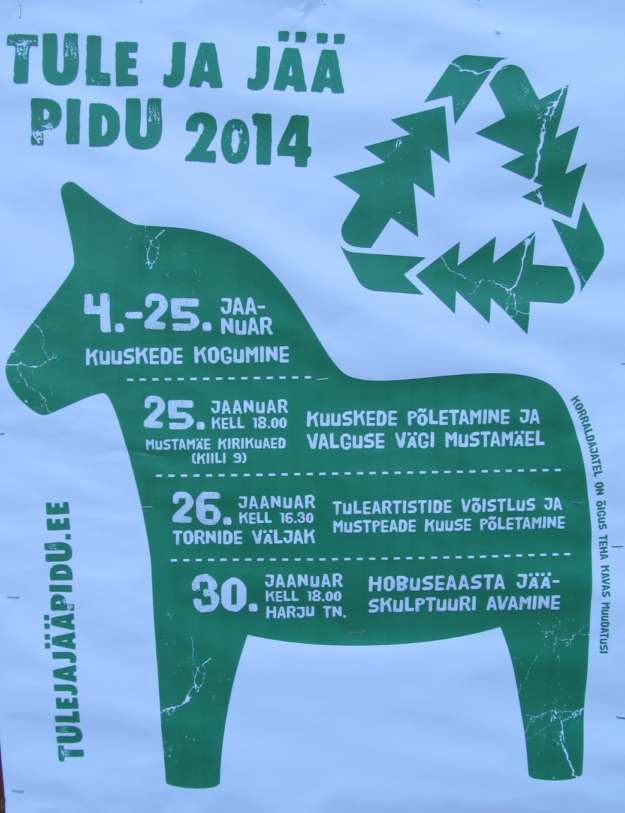 The annual FIRE AND ICE party in Tallinn, known for its fire sculptures, burning of Christmas trees (note the nifty tree recycling symbol) and ice sculptures, could also be interpreted as the COME AND STAY party. Such is the beauty of homonüümid or homonyms, words that share the same spelling and pronunciation but have different meanings. The various animal signs of the lunar calender hail from Chinese culture, but do you recognize the profile of this particular green wooden horse? Photo: Riina Kindlam
The annual FIRE AND ICE party in Tallinn, known for its fire sculptures, burning of Christmas trees (note the nifty tree recycling symbol) and ice sculptures, could also be interpreted as the COME AND STAY party. Such is the beauty of homonüümid or homonyms, words that share the same spelling and pronunciation but have different meanings. The various animal signs of the lunar calender hail from Chinese culture, but do you recognize the profile of this particular green wooden horse? Photo: Riina Kindlam
This TULE JA JÄÄ party’s events lasted throughout the month of jaanuar, starting with the collecting of jõulu/kuused (Christmas spruces), continuing with nende läitmine or setting them on fire, in a symbolic, ancient and moving way of course; then stepping up a notch with professional tule/artist (fire performers) and culminating in the unveiling of the sinise puu/hobuse jää/skulptuur (green wooden horse ice sculpture) in honour of Chinese New Year.
The hobu here is hobune (horse); hobu for short. And the one on the poster is a classic Northern European tõug or breed, so-to-speak – the outline of a very distinct Swedish Dala horse, from that country’s province of Dalarna, which has become one of the most widely known symbols of the entire country. So widely-known in fact, that even neighbors to the southeast are tempted to use it as the quintessential hobu. Although Estonia’s own breed, the purebred old-type or (vana-) Tori hobune, is a similar broad- and deep-chested working horse…
The classic, stoutly carved Dala/häst as it’s known in Swedish, is not green or blue, but reddish-orange with a distinct multicoloured painted lakk (mane), sadul and rakmed (harness).
You can always call a hobune a hobu, but never a jobu (jerk) or tobu (idiot). Distinguished members of the hobu family include the kiik/hobu (rocking horse), meri/hobu (sea horse) and jõe/hobu – “river horse”, i.e. hippopotamus.
A term of endearment for a horse is suksu. “Pani suksule päitsed pähe.” = “S/he put a bridle on the horse’s head.” If not wild, a hobu is also a ratsu, from the word ratsutama, (to ride) while sitting kaksi/ratsi (straddled). A ratsa/hobune (riding horse) could be a jahi/ratsu (hunting horse), sõja/ratsu (war horse), pulma/ratsu (wedding horse) or the small wooden ratsu that fits in your pocket, the malend (chess piece) known in English as the knight. If you arrived ratsa, you came on horseback – ratsa on your lovely ratsu. Ratsa/vägi is the cavalry or troops riding horses.
The one doing the riding is a ratsanik or ratsur. In Estonian, he or she urges on the hobu by saying NÕÕ! and makes him or her halt by saying PTRUU! That last one is hard to transcribe. You must flap your lips in a horse-like manner. Try saying “brrrrrr”, but keep your lips closed and pursed (torus). Someone driving a hobu/vanker or horse-drawn wagon or carriage would also use these käsklused (commands). Not to mention someone driving a regi (sledge) or saan (sleigh). Both are supported by runners (jalased), but saanid / sleighs are fancier and lighter (as seen in storybooks and Dr. Zhivago); reed / sledges are of a simpler, heavier construction, low to the ground and used for moving loads. “Saan oli sõiduks, regi tööks.” – A sleigh was for riding, a sledge for work. Happy trails on the lucky, roaming sinine puu/hobune!
Riina Kindlam,
Tallinn
















